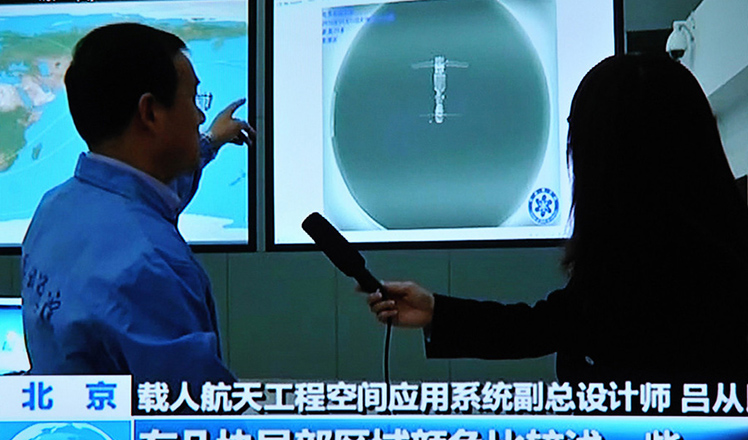China's 'Little Bee' searches for strongest blasts in universe
Updated: 2016-10-26 13:54
(Xinhua)
|
|||||||||
BEIJING -- A square-shaped probe, dubbed "Little Bee" by Chinese scientists, is searching for gamma-ray bursts, the strongest explosions in the universe.
The formal name of the probe, set atop China's first space lab Tiangong-2, is POLAR (an abbreviation of Polarimetry of Gamma-ray Bursts). The device will help open a new window in the study of gamma-ray astronomy, says Zhang Shuangnan, principal investigator on the POLAR project and a chief scientist at the High Energy Physics Institute of the Chinese Academy of Sciences.
Tiangong-2 was launched in September, and the Shenzhou-11 spacecraft last week took two astronauts to a 30-day mission in the space lab. They will prepare for the construction of a more complicated space station, conducting more than a dozen scientific experiments, most of them in cutting-edge fields of exploration.
POLAR is the only international cooperation project on Tiangong-2, involving scientists from the University of Geneva, Paul Scherrer Institute in Switzerland and Poland's Institute of Nuclear Physics.
"The 30-kg device can be regarded as a telescope, but it is different from other telescopes, as it consists of 1,600 sensitive components to detect the polarization of gamma-ray bursts. They are like the 1,600 facets in the compound eyes of bees. That's why we call it 'Little Bee' ," says Zhang.
"We hope to obtain accurate polarization information of the gamma-ray bursts for the first time ever to better understand the process of how the violent explosions happen," Zhang says.
Gamma-ray bursts are extremely energetic explosions that have been observed in distant galaxies. They are the brightest electromagnetic events known to occur in the universe. Bursts can last from ten milliseconds to several hours.
The intense radiation of most observed gamma-ray bursts is believed to be released during a supernova or hypernova as a rapidly rotating, high-mass star collapses to form a neutron star, quark star, or black hole. A subclass of bursts appear to originate from a different process: the merger of binary neutron stars.
Another aim of "Little Bee" is to determine whether gamma-ray bursts are related to gravitational waves. "If we can detect gamma-ray bursts at the same time gravitational waves happen, it will help us better understand gravitational waves. That will be very interesting," Zhang says.
He estimates that "Little Bee" can detect about 100 gamma-ray bursts during its two-year operating period.
Zhang also wants to try something outside the plan. He and his team have succeeded in locating signals from the Crab Pulsar neutron star by analyzing the data sent back by POLAR.
"This is the first time a Chinese space astronomical instrument has been used to study the remaining pulsar left by the supernova explosion recorded by the ancient Chinese nearly 1,000 years ago," Zhang says.
- Steps taken to 'speed up' corrupt fugitives' return
- World's first multiple-span cable-stayed bridge to open in Hunan
- Accompanying satellite sends back images of Tiangong II, Shenzhou XI
- China prefab house explosion kills 14, wounds 147
- 88 years old becomes oldest undergraduate in China
- Long March a 'stately monument': Xi
- Lavrov, Kerry discuss Syrian situation
- Turkish troops kill 17 IS militants since Mosul operation: FM
- 59 killed in attack on police academy in Pakistan
- Syrian forces capture new area in Aleppo
- Fate of child migrants uncertain before France demolishes Jungle camp
- Former Japan SDF official believed to have blown himself up, injures 3

 Tibet mandala: The world in a grain of sand
Tibet mandala: The world in a grain of sand
 Top 10 Chinese tycoons in IT industry
Top 10 Chinese tycoons in IT industry
 Planes ready to take off at Airshow China
Planes ready to take off at Airshow China
 Teacher's spirit keeps village school open
Teacher's spirit keeps village school open
 A sweet wedding worth waiting for
A sweet wedding worth waiting for
 Top 5 property destinations for Chinese investors
Top 5 property destinations for Chinese investors
 Accompanying satellite sends back images of Tiangong II, Shenzhou XI
Accompanying satellite sends back images of Tiangong II, Shenzhou XI
 Dare you jump
Dare you jump
Most Viewed
Editor's Picks

|

|

|

|

|

|
Today's Top News
'Zero Hunger Run' held in Rome
Trump outlines anti-terror plan, proposing extreme vetting for immigrants
Phelps puts spotlight on cupping
US launches airstrikes against IS targets in Libya's Sirte
Ministry slams US-Korean THAAD deployment
Two police officers shot at protest in Dallas
Abe's blame game reveals his policies failing to get results
Ending wildlife trafficking must be policy priority in Asia
US Weekly

|

|









